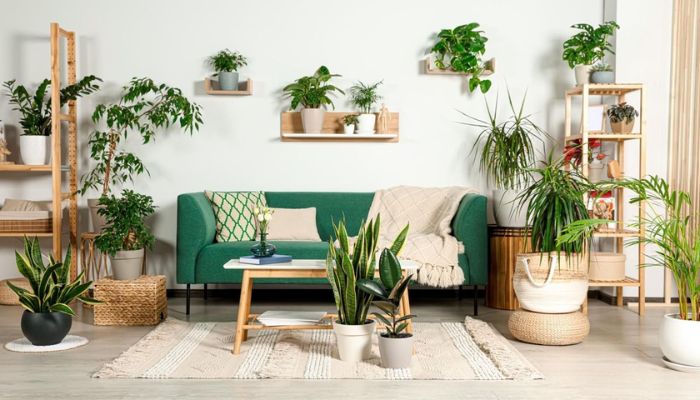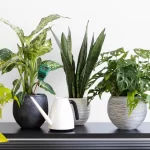I’ve been taking care of houseplants for seven years and have learned a lot about which types do best indoors and bring life into rooms. As someone who loves indoor gardening and lives on the fourth floor, I’ve tried hundreds of houseplants to find the ones that make homes look their best. Let’s read below about “Which Houseplants Are Best for Brightening Up Your Home?”.
After a lot of trial and error with things like light exposure, seasonal changes, and watering needs, I’ve come up with a list of my top 5 favorite houseplants that will add natural beauty to your home without needing too much care.
Best 5 Houseplants for Brightening Up Your Home
Pothos
Pothos is a classic choice for adding greenery and life to homes because it grows on vines and has heart-shaped leaves. Pothos looks beautiful hanging from baskets and shelves. It only needs to be watered once a week and gets medium-level indirect light. With soft plant ties, I’ve even been able to get pothos to climb wooden posts.
One of my favorite things about pothos is that its leaves turn yellow or brown when it needs a little extra care. It’s been seven years, and I still have a lot of healthy pothos plants that I took good care of.
Chinese Evergreen
Few plants can handle low light as well as the Chinese evergreen and still have lush leaves, in my experience. Its different shades of green, silver, pink, and cream give rooms a lot of variety and depth.
Chinese evergreens grow more slowly than other plants, but they don’t need much care. As long as they get low to medium indirect light, I’ve found that watering these plants once every seven to ten days is enough. The most colorful evergreens in China I’ve made sure they get bright, indirect light for two to four hours a day.
Philodendrons
I think philodendrons are the most useful houseplants I’ve ever grown. Philodendron species and cultivars come in a wide range of shapes, such as vines, shrubs, and trailers, which lets them grow in almost any setting. Some types need more light than others, but most will do well with bright, indirect light and weekly watering.
One reason I love philodendrons so much is that they’re very tough and don’t mind if their soil dries out a little longer than expected. Philodendron plants t
hat I forgot about while I was traveling just came back to life after being watered well. That’s what they mean to me: beauty that doesn’t need much care.
Succulents
Succulents are becoming more and more popular among people who like houseplants, and for good reason. Like Echeveria and Jade plants, they look great on desks, tabletops, and window sills because of their sculptural shapes, beautiful colors, and interesting textures.
I learned the hard way that overwatering succulents is the most common mistake plant parents make, which causes them to rot and die. Now I give these plants as much bright light as I can and wait until the soil is completely dry between waterings. This makes succulents great houseplants that don’t need much care.
Snake Plant
Snake plants are very hardy and can survive in harsh indoor conditions like low light and irregular watering. Snake plants have stiff, upright leaves that come in beautiful yellow-edged and twisty styles. Once they are established, they don’t need much care.
I’ve put snake plants in dozens of places in my home, ranging from bright, indirect light to almost dark corners, and they do well everywhere. Snake plants will give you bright, vertical greenery if you let the soil dry out completely between waterings once a week.
Caring for Houseplants Year-Round
Basic care for my top 5 recommended houseplants keeps them healthy, but I’ve learned some best ways to help indoor plants not only survive but thrive all year long. Here are a few of my best suggestions:
Spring
After winter dormancy, check plants for pests and cut back any damaged leaves. Gradually increase how often you water plants as they come out of dormancy. To get the most light through the leaves, wash off the dust.
Summer
Mist plants often make them feel like they are in the humid tropical climates where many houseplants come from. Every month, use balanced liquid fertilizer to help plants grow. To keep plants from getting shocked, move them out of drafty areas.
Fall
Move plants to their best places for fall and winter before the weather gets cold. Lessen how often you water and stop fertilizing six weeks before winter. Get rid of the yellowing leaves to focus on the healthy ones.
Winter
Don’t water too much; only water when the soil is almost dry. Take plants out of drafty or cold places, like around doors. Putting plants together will make it warmer and more humid. If the amount of sunlight drops a lot, add grow lights.
How Fun It Is to Take Care of Houseplants
Over the past seven years, taking care of colorful houseplants has been a very enjoyable hobby for me. Every day, seeing different plants grow into focal points around my house gives me energy and ideas. Nothing beats the happiness that comes from growing things indoors with so little work.
Transition plants to optimal fall and winter placements before temperatures drop. Reduce watering frequency and stop fertilizing 6 weeks before winter. Remove yellowed leaves to focus energy on viable foliage. Hope you get all the information on “Which Houseplants Are Best for Brightening Up Your Home?”.

Katia Hougaard is a PhD candidate at Imperial College London, specializing in plant-aphid interactions. With a background in Plant Biology from the University of Texas at Austin, she focuses on the genetic and physiological resistance of Medicago truncatula to pea aphids. Katia has served as a science advisor for startups in vertical farming and the houseplant industry. She also mentors students and manages a research lab, contributing her expertise to both academic and entrepreneurial projects. At SuperbPlants.com, Katia shares her in-depth knowledge of plant biology, emphasizing sustainable practices and scientific integrity.






